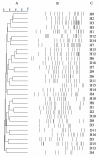Gut microbiota in children with type 1 diabetes differs from that in healthy children: a case-control study
- PMID: 23433344
- PMCID: PMC3621820
- DOI: 10.1186/1741-7015-11-46
Gut microbiota in children with type 1 diabetes differs from that in healthy children: a case-control study
Abstract
Background: A recent study using a rat model found significant differences at the time of diabetes onset in the bacterial communities responsible for type 1 diabetes modulation. We hypothesized that type 1 diabetes in humans could also be linked to a specific gut microbiota. Our aim was to quantify and evaluate the difference in the composition of gut microbiota between children with type 1 diabetes and healthy children and to determine the possible relationship of the gut microbiota of children with type 1 diabetes with the glycemic level.
Methods: A case-control study was carried out with 16 children with type 1 diabetes and 16 healthy children. The fecal bacteria composition was investigated by polymerase chain reaction-denaturing gradient gel electrophoresis and real-time quantitative polymerase chain reaction.
Results: The mean similarity index was 47.39% for the healthy children and 37.56% for the children with diabetes, whereas the intergroup similarity index was 26.69%. In the children with diabetes, the bacterial number of Actinobacteria and Firmicutes, and the Firmicutes to Bacteroidetes ratio were all significantly decreased, with the quantity of Bacteroidetes significantly increased with respect to healthy children. At the genus level, we found a significant increase in the number of Clostridium, Bacteroides and Veillonella and a significant decrease in the number of Lactobacillus, Bifidobacterium, Blautia coccoides/Eubacterium rectale group and Prevotella in the children with diabetes. We also found that the number of Bifidobacterium and Lactobacillus, and the Firmicutes to Bacteroidetes ratio correlated negatively and significantly with the plasma glucose level while the quantity of Clostridium correlated positively and significantly with the plasma glucose level in the diabetes group.
Conclusions: This is the first study showing that type 1 diabetes is associated with compositional changes in gut microbiota. The significant differences in the number of Bifidobacterium, Lactobacillus and Clostridium and in the Firmicutes to Bacteroidetes ratio observed between the two groups could be related to the glycemic level in the group with diabetes. Moreover, the quantity of bacteria essential to maintain gut integrity was significantly lower in the children with diabetes than the healthy children. These findings could be useful for developing strategies to control the development of type 1 diabetes by modifying the gut microbiota.
Figures

Similar articles
-
Impact of type 1 diabetes on the composition and functional potential of gut microbiome in children and adolescents: possible mechanisms, current knowledge, and challenges.Gut Microbes. 2021 Jan-Dec;13(1):1-18. doi: 10.1080/19490976.2021.1926841. Gut Microbes. 2021. PMID: 34101547 Free PMC article. Review.
-
Gut microbiota composition in male rat models under different nutritional status and physical activity and its association with serum leptin and ghrelin levels.PLoS One. 2013 May 28;8(5):e65465. doi: 10.1371/journal.pone.0065465. Print 2013. PLoS One. 2013. PMID: 23724144 Free PMC article.
-
Molecular characterisation of the faecal microbiota in patients with type II diabetes.Curr Microbiol. 2010 Jul;61(1):69-78. doi: 10.1007/s00284-010-9582-9. Epub 2010 Jan 20. Curr Microbiol. 2010. PMID: 20087741
-
Gut microbiota profile in healthy Indonesians.World J Gastroenterol. 2019 Mar 28;25(12):1478-1491. doi: 10.3748/wjg.v25.i12.1478. World J Gastroenterol. 2019. PMID: 30948911 Free PMC article.
-
Gallstone Disease, Obesity and the Firmicutes/Bacteroidetes Ratio as a Possible Biomarker of Gut Dysbiosis.J Pers Med. 2020 Dec 25;11(1):13. doi: 10.3390/jpm11010013. J Pers Med. 2020. PMID: 33375615 Free PMC article. Review.
Cited by
-
Diversity of Intestinal Clostridium coccoides Group in the Japanese Population, as Demonstrated by Reverse Transcription-Quantitative PCR.PLoS One. 2015 May 22;10(5):e0126226. doi: 10.1371/journal.pone.0126226. eCollection 2015. PLoS One. 2015. PMID: 26000453 Free PMC article.
-
Altered CD161 bright CD8+ mucosal associated invariant T (MAIT)-like cell dynamics and increased differentiation states among juvenile type 1 diabetics.PLoS One. 2015 Jan 27;10(1):e0117335. doi: 10.1371/journal.pone.0117335. eCollection 2015. PLoS One. 2015. PMID: 25625430 Free PMC article.
-
Prediction and prevention of type 1 diabetes: update on success of prediction and struggles at prevention.Pediatr Diabetes. 2015 Nov;16(7):465-84. doi: 10.1111/pedi.12299. Epub 2015 Jul 23. Pediatr Diabetes. 2015. PMID: 26202050 Free PMC article. Review.
-
Impact of type 1 diabetes on the composition and functional potential of gut microbiome in children and adolescents: possible mechanisms, current knowledge, and challenges.Gut Microbes. 2021 Jan-Dec;13(1):1-18. doi: 10.1080/19490976.2021.1926841. Gut Microbes. 2021. PMID: 34101547 Free PMC article. Review.
-
Causal relationship between gut microbiota and immune thrombocytopenia: a Mendelian randomization study of two samples.Front Microbiol. 2023 Nov 23;14:1190866. doi: 10.3389/fmicb.2023.1190866. eCollection 2023. Front Microbiol. 2023. PMID: 38075905 Free PMC article.
References
-
- Ehehalt S, Dietz K, Willasch AM, Neu A, Baden-Württemberg. Diabetes Incidence Registry (DIARY) Group. Epidemiological perspectives on type 1 diabetes in childhood and adolescence in Germany: 20 years of the Baden-Württemberg Diabetes Incidence Registry (DIARY) Diabetes Care. 2010;3:338–340. - PMC - PubMed
-
- Patterson CC, Dahlquist G, Soltesz G, Green A. Grp EAS. Is childhood onset Type I diabetes a wealth-related disease? An ecological analysis of European incidence rates. Diabetologia. 2001;4:9–16. - PubMed
-
- Brugman S, Klatter FA, Visser JT, Wildeboer-Veloo AC, Harmsen HJ, Rozing J, Bos NA. Antibiotic treatment partially protects against type 1 diabetes in the Bio-Breeding diabetes-prone rat. Is the gut flora involved in the development of type 1 diabetes? Diabetologia. 2006;49:2105–2108. doi: 10.1007/s00125-006-0334-0. - DOI - PubMed
Publication types
MeSH terms
LinkOut - more resources
Full Text Sources
Other Literature Sources
Medical

